Need to clean your fabric upholstery? I tested 10 homemade upholstery cleaner tutorials to find the best DIY solution. The best homemade upholstery cleaner is an all-natural cleaner that removes upholstery stains with only 3 simple ingredients. Plus I found the best brightening upholstery cleaner, the best dry upholstery cleaner, and the best upholstery stain remover.
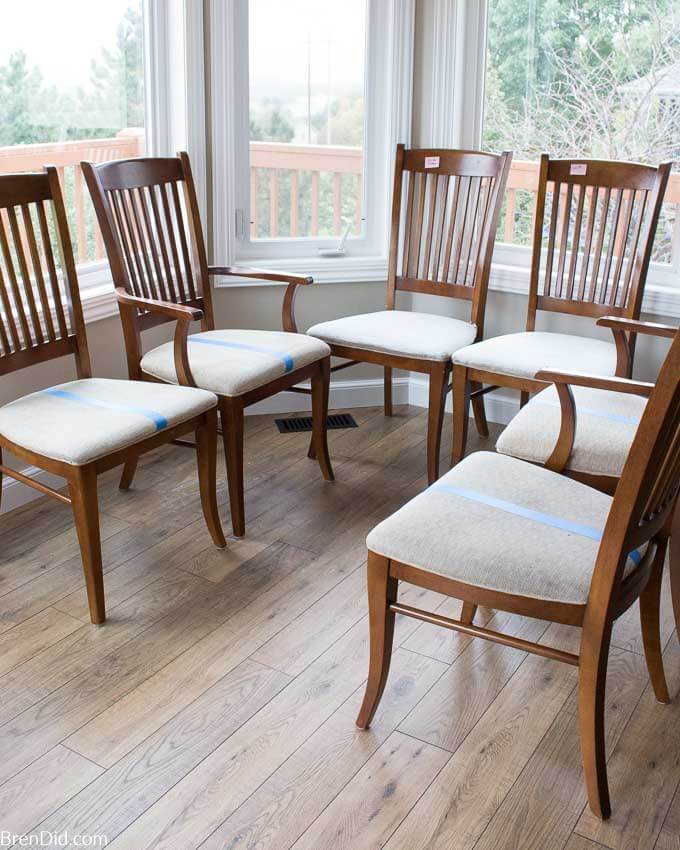
My husband and I started our marriage with very little furniture of our own. We had a hand-me-down couch, our bedroom furniture, and a tiny kitchen table inherited from his parents. We were DELIGHTED when we made our first “grown-up” furniture purchase… a dining room table and chairs!
Fast forward 18 years, our table and chairs have been through seven moves, two kids, and three pets. It’s served as a homework desk, a craft station, a Thanksgiving dining table, a birthday party location, and more. It was looking ready for Craigslist!
The cream-colored upholstered seats were dingy and spotted with food stains, blobs of color left by paint and markers, ink and pencil marks, grape juice splotches, and many more mystery spots.
Before giving the dining set up for good I decided to give it a deep cleaning. Step one: Find a natural upholstery cleaner that would make the fabric-covered seats look new.
DIY Upholstery Cleaners
Upholstery cleaning can be a lot of work! It takes time and elbow grease to remove set-in stains and grime. I was determined to find an easy-to-use DIY cleaning solution that could remove stains and discolorations without using toxic ingredients.
My search uncovered many conflicting opinions and cleaners with vastly different ingredients. What’s a green cleaning lover to do?
Conduct a natural upholstery cleaner test!
*I confess. I’m addicted to testing homemade cleaners! (I’ve also tested natural grout cleaners and non-toxic oven cleaners.) I love finding which of the cleaners work best and which are cleaning disasters.
The Upholstery Cleaner Experiment
I decided to try the eight most popular upholstery cleaners on Pinterest to find the best homemade solution.
Methodology
I tested each upholstery cleaner on the same surface (my dining room chairs) and used the same process to test each cleaner:
- I divided the chairs into sections using painter’s tape and numbered each section.
- I mixed a batch of upholstery cleaner, applied it to a section of chair, then followed the instructions for the cleaner.
- I repeated step 2 seven more times using different cleaners and different sections of the chairs.
- Finally, I waited overnight for the chairs to dry completely and then recorded the results.
Upholstery Cleaner Results
The results of the cleaning test were a bit of a shock… NONE of the 8 cleaners met my standards of cleaning well and being easy to use.
- Two worked well but took multiple rinsing to remove the cleaner and lots of drying time.
- Two cleaned well but made a huge mess.
- Two didn’t do much cleaning at all.
- Two were great stain removers but not great overall cleaners.
I went back to the drawing board, adjusted the two best cleaners so they would be easier to rinse, and then retested.
Both of the new upholstery cleaners (cleaners 9 and 10) are easy to use and clean well. Score one for the green-cleaning nerd!
The Tested Upholstery Cleaners
These are the 8 DIY upholstery cleaners tested. The winning formulas are marked.
Upholstery Cleaner #1
Ingredients: 1/2 cup dish soap, 1 cup hydrogen peroxide (3%)
Directions: Lightly spray the upholstery. Let the upholstery cleaner sit on the fabric for 2-3 minutes. Scrub gently with a microfiber cloth or rag. If the fabric feels soapy wet and gently blot.
Results: Too many bubbles! I had to rinse the fabric multiple times and eventually resorted to using my steam cleaner and shop vac to suck the seats dry. The fabric was clean when I finished but the process took hours. I would not clean a larger surface with this cleaner.
Why this cleaner doesn’t work: 1) This cleaner contains an overwhelming amount of detergent which makes the fabric extremely soapy. Any residue left behind can make the fabric feel crunchy and attract more dirt. 2) Using too much water to rinse when cleaning upholstery can leave a musty smell or damage metal zippers, wood furniture components, etc.
Upholstery Cleaner #2
Ingredients: 1 cup club soda, 1 cup vinegar, 1 cup dish detergent
Directions: Mix cleaner in a spray bottle, spray onto upholstery until the surface is lightly soaked. Allow the cleaner to dwell for a few minutes. Scrub lightly with a brush in a circular motion. Spray with water and suck dry with a steam cleaner or shop vac.
Results: Too much detergent! I had to spray the fabric with water multiple times to rinse and then vacuum dry. ( I moved from using my mini Bissel to my powerful shop vac since it had more suction.) The fabric was quite clean when I finished but it was a long, hard process.
Why this cleaner doesn’t work: 1) This cleaner contains an overwhelming amount of detergent which makes the fabric extremely soapy. Any residue left behind can make fabric feel crunchy and attract more dirt. 2) Using too much water to rinse when cleaning upholstery can leave a musty smell or damage metal zippers, wood furniture components, etc.
Upholstery Cleaner #3
Ingredients: 1 tbsp dish soap, 1 tbsp white vinegar, 2 cups hot water, baking soda
Directions: Sprinkle baking soda on the stain and wait 10 minutes. Vacuum up the baking soda. Mix the dish soap, vinegar, and water in a spray bottle. Lightly soak the fabric, blot dry.
Results: This mixture did not do much to clean and remove stains. This may be because it contains such a small amount of vinegar. I would not use it again.
Upholstery Cleaner #4 (Best Upholstery Stain Remover)
Ingredients: 1 c rubbing alcohol, 1 c white vinegar
Directions: Mix ingredients together in a spray bottle. Spray the fabric surface generously with cleaner and allow to dwell for 1-2 minutes. Scrub vigorously with a sponge or clean towel, then allow to dry. Repeat if needed.
Results: This mixture helped to remove the paints and ink stains. However, the solution did not do much to clean the fabric in general. I would use this cleaner to spot treat difficult stains. (Warning: Do not use alcohol on acetate, triacetate, modacrylic, and acrylic fibers.)
Why this cleaner works (and doesn’t work): 1) Alcohol-based cleaners can effectively remove paint, ink, and tough stains from fabric. 2) Vinegar is a weak acid that breaks down basic soils and naturally eliminates odors as it dries. 3) The solution did not do much to clean the overall fabric because it does not contain any detergents to break down dirt and oils.
Upholstery Cleaner #5
Ingredients: 1 tbsp white vinegar, 2/3 cup rubbing alcohol
Directions: Mix ingredients together in a spray bottle. Spray fabric surface generously with cleaner and allow to sit for 1-2 minutes. Scrub with a clean rag, allow to dry. Repeat if needed.
Results: Like cleaner #4 this mixture helped to remove ink stains because it contains rubbing alcohol, but it did not clean the fabric in general. I would skip this cleaner and simply dab a few drops of plain rubbing alcohol on ink stains. (Warning: Do not use alcohol on acetate, triacetate, modacrylic, and acrylic fibers.)
Upholstery Cleaner #6 (Best Dry Upholstery Cleaner)
Ingredients: 1/2 cup baking soda, 1/2 cup cornstarch, a small amount of water
Directions: Combine the ingredients with just enough water to form a thick paste. Apply to fabric and allow to dry (this should take about half an hour). When the paste is dry vacuum the fabric clean. (You can also mix baking soda and cornstarch, sprinkle on, wait about an hour and vacuum away.)
Results: I was amazed at how well this cleaner lifted out some fabric stains! You could see spots rising to the surface of the cleaner. This cleaner works well for light cleaning and on delicate upholstery that should not get too wet.
Why this cleaner works: 1) Baking soda is a basic cleaner that is mildly abrasive so it breaks down acidic soils and odors. 2) Cornstarch is excellent at absorbing moisture, oil, and smells.
Upholstery Cleaner #7
Ingredients: 1 tsp dish soap, water, hydrogen peroxide (50% solution), baking soda
Directions: Combine dish soap and 1 cup of warm water in one spray bottle, combine equal parts of hydrogen peroxide and water in a second bottle to create a 50% solution. Spray fabric with soapy water until lightly saturated, spray evenly with the hydrogen peroxide solution, and sprinkle with baking soda. Use your hand or cloth to spread baking soda evenly across the surface. Allow to dry overnight. Vacuum clean.
Results: This cleaner did a great job removing stains and brightening the fabric overall. However, it was extremely messy to apply and hard to vacuum clean. I would not use this cleaner on dark fabrics as it could bleach them. It would also be difficult to remove from large surfaces.
Why this cleaner works: 1) Dish washing detergent cuts through dirt and greasy grime. 2) Hydrogen peroxide is a natural alternative to bleach that brightens fabric and lightens the color of tough stains. 3) Baking soda is a basic cleaner that is mildly abrasive so it breaks down acidic dirts and odors.
Upholstery Cleaner #8
Ingredients: 1 tsp dish soap, 16 ounces water, Hydrogen peroxide (100% solution), Baking soda
Directions: Combine dish soap and water in one spray bottle, pour hydrogen peroxide into a dark spray bottle. Spray fabric with soap water until lightly saturated, spray evenly with hydrogen peroxide, and sprinkle with baking soda. Use your hand or cloth to spread baking soda evenly across the surface. Allow to dry overnight. Vacuum clean.
Results: This cleaner did a great job removing stains and brightening the fabric (it brightened even more than the 50% solution). However, it was extremely messy to apply and vacuum away. I would not use this cleaner on dark fabrics as it could bleach them too much. It would also be difficult to remove from large surfaces.
Why this cleaner works: 1) Dish washing detergent cuts through dirt and greasy grime. 2) Hydrogen peroxide is a natural alternative to bleach that brightens fabric and lightens the color of tough stains. 3) Baking soda is a basic cleaner that is mildly abrasive so it breaks down acidic soils and odors.
The Winning DIY Upholstery Cleaners
The 4 best formulas from the test can be found below:
Best Homemade Upholstery Cleaner
Ingredients: 1 c water or club soda (I tested both water and club soda, both worked well), ½ c white vinegar, ½ Tbsp natural dish soap
Directions: Mix cleaner in a spray bottle, spray onto upholstery until the surface is lightly soaked. Allow the cleaner to dwell for a few minutes. Scrub lightly with a brush or rag in a circular motion. Spray with water and suck dry with a shop vac.
Results: This is my revised version of cleaner #2. It is a water-based cleaner that works well and eliminates the problem of too much soap/foam. This is a great, general upholstery cleaner.
Why this cleaner works: 1) Water breaks up and dissolves substances allowing them to be swept away. 2) Vinegar is a mild acid that breaks down basic soils and neutralizes odor-causing particles. 3) Dishwashing detergent cuts through spills, dirt, and greasy grime.
Best Brightening Upholstery Cleaner
Ingredients: 1 c hydrogen peroxide (3%), ½ Tbsp natural dish soap
Directions: Mix cleaner in a spray bottle, spray onto upholstery until the surface is lightly soaked. Allow the cleaner to dwell for a few minutes. Scrub lightly with a brush or rag in a circular motion. Spray with water and suck dry with a shop vac.
Results: This is my revised version of cleaner #1. It cleans and brightens well and eliminates the problem of too much soap. I would not use this cleaner on dark fabrics as it could bleach them too much. This is a good upholstery cleaner for light fabrics that need brightening and stain removal.
Why this cleaner works: 1) Hydrogen peroxide is a natural alternative to bleach that brightens fabric and lightens the color of tough stains. 2) Dish washing detergent cuts through dirt and greasy grime. 3) Water breaks up and dissolves substances allowing them to be swept away.
Best Dry Upholstery Cleaner
Ingredients: 1/2 cup baking soda, 1/2 cup cornstarch, a small amount of water
Directions: Combine the ingredients in a bowl with just a bit of water to form a thick paste. Apply to fabric and allow to dry (this should take about half an hour). When the paste is dry vacuum the fabric clean. (You can also omit the water; simply mix baking soda and cornstarch, sprinkle on fabric, wait about an hour and vacuum away.)
Results: This cleaner helps to lift stains and deodorize fabric. It is best for light cleaning and on delicate upholstery that should not get too wet.
Why this cleaner works: 1) Baking soda is a basic cleaner that is mildly abrasive so it breaks down acidic soils and odors. 2) Cornstarch is excellent at absorbing moisture, oil, and smells.
Best Upholstery Stain Remover
Ingredients: 1 c rubbing alcohol, 1 c white vinegar
Directions: Mix ingredients together in a spray bottle. Spray the stained areas with cleaner and allow it to dwell for 1-2 minutes. Blot or scrub with a dry cloth, then allow the fabric to dry. Repeat until the stain lightens.
Results: This mixture helps to remove the stains like paint and ink. Use it to spot treat difficult stains before applying one of the other homemade upholstery cleaners. (Warning: Do not use alcohol on acetate, triacetate, modacrylic, and acrylic fibers.)
Why this stain remover works: 1) Alcohol-based cleaners can effectively remove paint, ink, and tough stains from fabric. 2) Vinegar is a weak acid that breaks down basic soils and naturally eliminates odors as it dries.
Which Upholstery Cleaner Is Best?
There is a wide range of upholstery fabrics, chose the cleaner that works best for your fabric (be sure to spot-test all cleaners and check tags for manufacturer recommendations):
- The best general upholstery cleaner: 1 cup of water or club soda, ½ cup white vinegar, ½ tablespoon of natural dish soap (cleaner #10)
- The best brightening upholstery cleaner for light-colored fabric: 1 cup hydrogen peroxide (3%) mixed with ½ tablespoon natural dish soap (cleaner #9)
- The best dry upholstery cleaner: equal parts of baking soda and cornstarch (cleaner #6).
- The best upholstery spot remover: 1 cup of rubbing alcohol and 1 cup of white vinegar (cleaner #4).
- The best way to clean car seats: Vacuum seats well, spray lightly with upholstery cleaner (1 cup of water or club soda, ½ cup white vinegar, ½ tablespoon of natural dish soap), let the cleaner sit for 5 minutes, rub fabric in a circular motion with a soft brush or clean microfiber rag. Spray lightly with water and suck dry with a steam cleaner or shop vac. Allow to dry. (This method should be used on fabric car seats only.)
- How to deodorize upholstery: There are 3 great ways to deodorize upholstery. 1) Spray with homemade refresher spray 2) Sprinkle with a mixture of cornstarch, baking soda, and a few drops of essential oils (get full instructions) 3) Spritz lightly with a 50% solution of white vinegar and 50% water (add a few drops of essential oils if desired), allow to dry.
- How to clean leather upholstery: I clean leather with this mixture. Be sure to spot-test and check tags for manufacturer recommendations.
How to Make Upholstery Cleaner
This easy homemade upholstery cleaner with just 3 ingredients can make any fabric-covered surface look brand new.
- Ingredients: 1 c water or club soda (I used club soda), ½ c white vinegar, ½ Tbsp natural dish soap
- Directions: Mix cleaner in spray bottle. Use immediately or store up to one month in a cool location.
How to Use Upholstery Cleaner
Spray upholstery cleaner onto the fabric surface to lightly saturate. Allow the cleaner to dwell for a few minutes. Scrub lightly with a brush or rag in a circular motion. Spray lightly with water or wipe with a wet cloth and blot dry or vacuum dry with a shop vac or steam cleaner.
Upholstery Cleaning Tips
- Spot test the cleaner. There are many, many types of fabric used in upholstery. It is always a good idea to test a small, hidden spot before applying the cleaner to the entire surface. (For example, test the back of sofas or the underside of couch cushions.)
- Use as little cleaner as possible. It is easy to add more cleaner, it is hard to remove the extra cleaner from upholstered surfaces. Start with a little solution and add more as needed.
- Protect other surfaces. My floor got a great cleaning during this test! (It was swept, scrubbed, and rinsed multiple times to remove excess upholstery cleaner.) Make your life easier by covering areas you do not want to clean with a large towel or sheet.
- Remove the fabric-covered area if possible. My chair seats can be unscrewed from the wooden base. Taking the chairs apart made it easier to clean the entire seat without getting the wood too wet. It also gave me a chance to clean the wooden chair parts separately.
- Try different cleaning tools. A small brush, cotton rag, or microfiber cloth can boost the cleaning power of your fabric cleaner. Work the solution in using a light circular motion. Do not scrub too hard or the upholstery may pill.
- Give the fabric cleaner some dwell time.You’ll get the best results if you allow your favorite upholstery cleaner some time to work (also called dwell time) before you start scrubbing. Let the cleaner sit on the fabric for 5-10 minutes then continue cleaning.
- Vacuum first… and last! Remove excess dirt and debris from the upholstery with a vacuum before you begin cleaning. Once the surface is 100% dry run the vacuum over it again to help fluff the fabric and underlying upholstery foam. I use a shop vac for maximum suction but any vacuum with a hose attachment will work!
Do you have upholstery cleaning experience? I’d love to hear your favorite DIY method. Comment below with your favorite cleaner or stop by my Facebook page.
Like my green cleaning tutorials? Sign up for my free newsletter and never miss a thing.



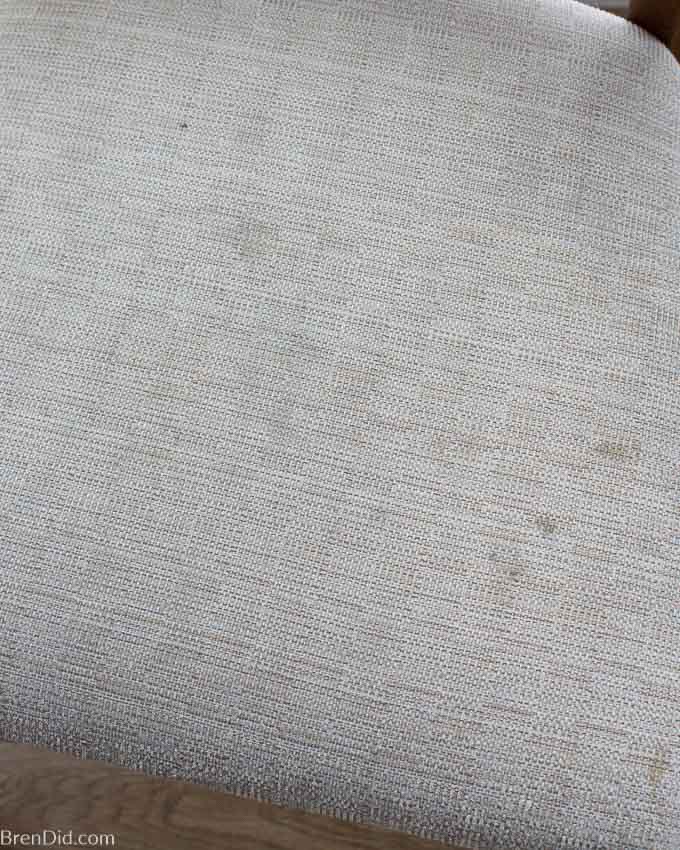
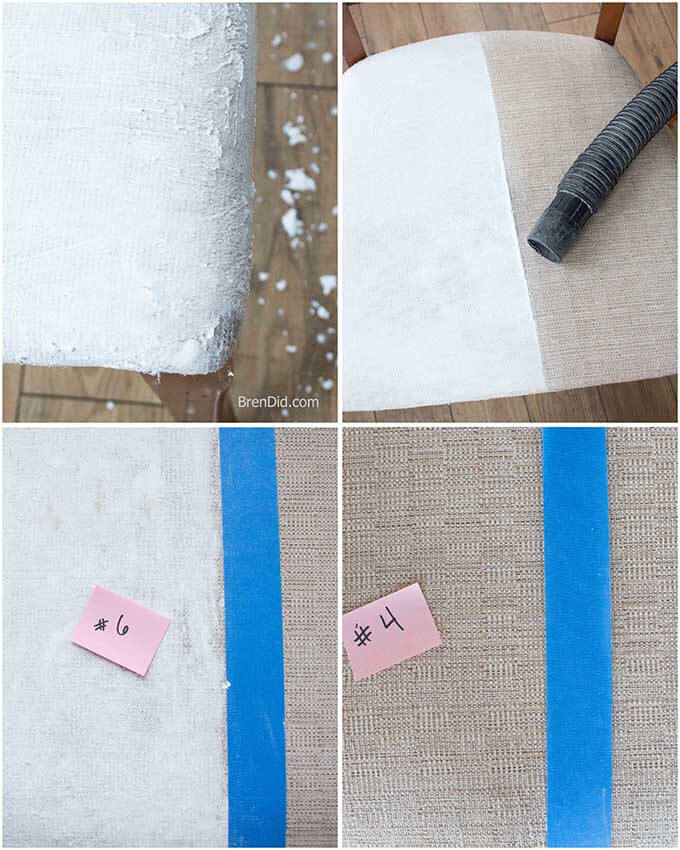
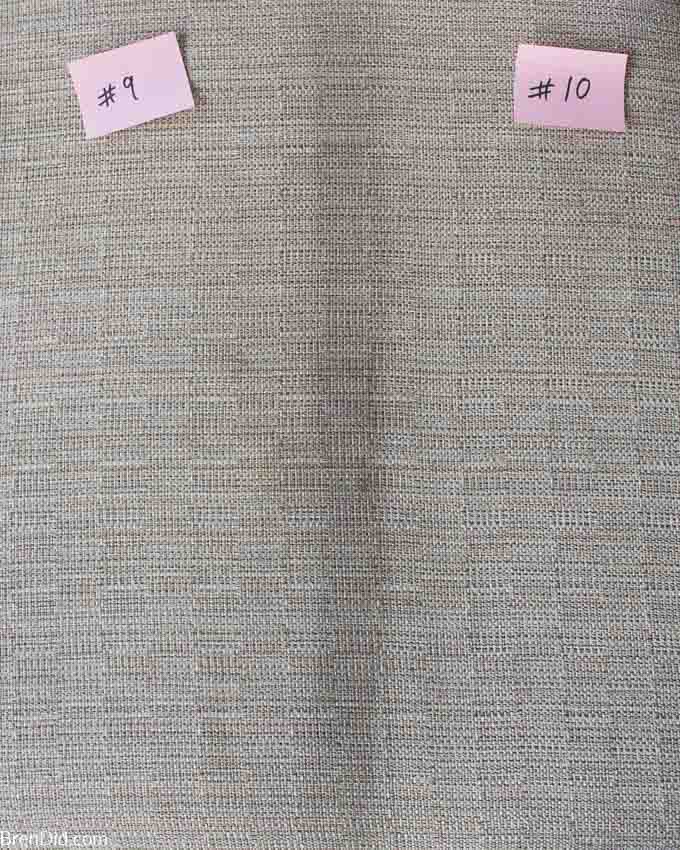
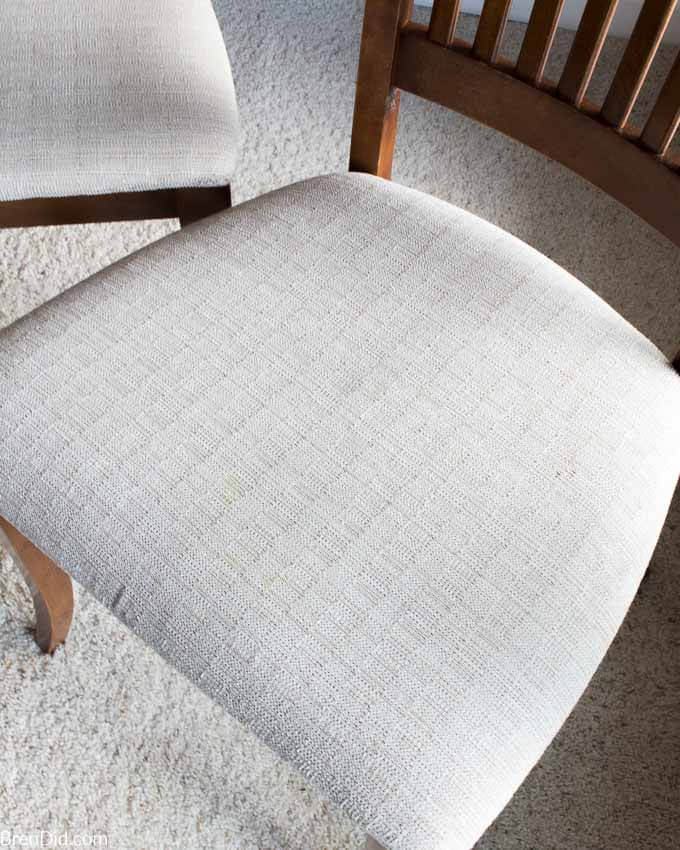
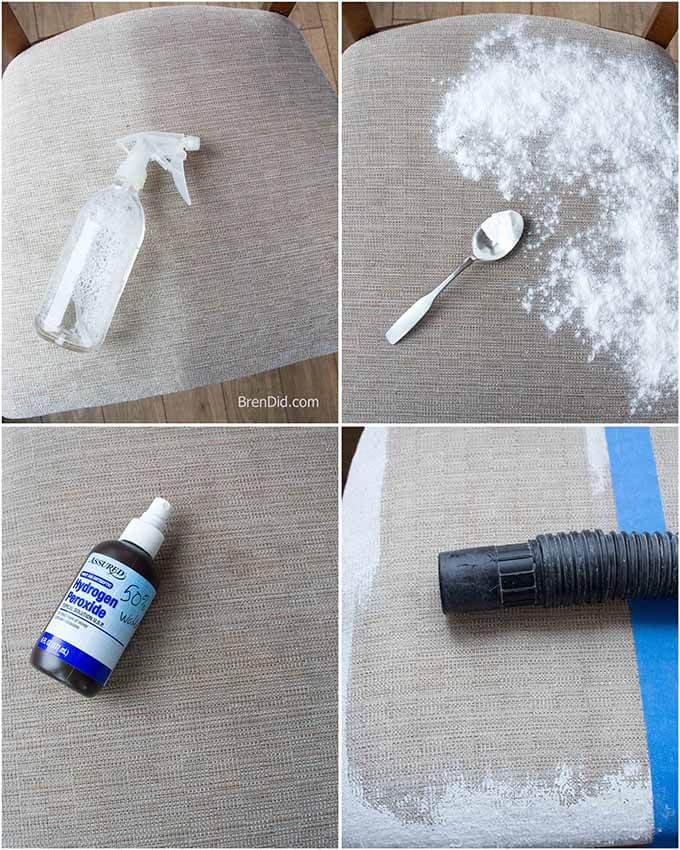
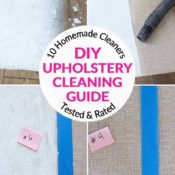
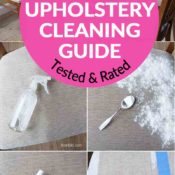
Shelby
I’m late to the game, but I love these tips, Bren! I’ve been looking for a green way to accomplish upholstery cleaning, so I’m excited to try this out this weekend.
Olamide Moronkola
Yooooo This is great work. Really great. Less water Less Soap quick dry time and refreshing odor! Customers are happy.
Rachel
I just had to come on here and say THANK YOU!!! this has all of the resources and knowledge I was looking for! I so appreciate you for this article!
Karen
I used the club soda,vinegar,dish soap formula on my extremely soiled outdoor furniture cushions…. It is truly a miracle cleaner. My cushions look new again. Thank you so much for your diligence to test all the different combinations and then report the results. It certainly saved me the angst of trying to decide In the best one for my need.
Bren
Wooo hooo! I’m so glad the cleaner worked for you, Karen! I do love a good cleaner test! 😉
Ms
Hi there, I tried number 6
And my couch got white stains. Is there anything I can do to remove cornstarch from my couch ?
Thanks
Bren
The white spots might be residue from the baking soda or cornstarch. I would vacuum it with a powerful vacuum to get out the excess powder. If this dow not work try spot cleaning lightly with a mixture of 50% water and 50% white vinegar to help break down the baking soda. Do not oversaturate! As every piece of upholstery is different I recommend spot testing any cleaner (store-bought or homemade) in an inconspicuous spot before using on a large area. Good luck!
BOBBIE
WILL ANY OF THESE WORK ON MATTRESSES TOO??? THANKS.
Bren
I would use this technique for mattresses: https://www.apieceofrainbow.com/clean-mattress-stains-green-cleaning/
Hills
So…I think it’s important to mention the odor of using vinegar on fabric. I decided to use the DIY recipe with vinegar, water & dish soap for cleaning a friends car interior. Unfortunately the car wreaked like we just opened a bag of salt & vinegar chips when opening the door even when the fabric was dry! (Day 2 now). The next day I used a different one of your solutions (hydrogen peroxide based) to reclean the interior. Then used a microfiber cloth dampened with plain water to scrub and absorb as much of the cleaning solution as possible. Finally, I used a shop vac to vacuum up excess solution. Her car still smells of vinegar! While it did a great job cleaning her seats (light colored and visibly soiled), the smell is not one you want to have lurking in your vehicle. Perhaps a mention of adding a lemon peel or other vinegar neutralizer would be noteworthy in this list of cleaners that include vinegar ESPECIALLY when cleaning such a porous surface such as fabric. Thanks for doing all the testing however!
Bren
You definitely want to go lightly when applying the vinegar cleaning solution (or any cleaner) and let the car dry with the windows open. When vinegar is 100% dry it will leave no odor. If you oversaturate the interior it will be hard to get the seats dry inside and the odor will remain. I am glad you got the results you wanted in the end!
Karen S Mergner
Bren, thank you for your methodical approach to determining what works on different types of fabric. I have just finished stage one of DIY steam cleaning and dry vac on a settee using both hydrogen peroxide and vinegar to prep, then mixing vinegar and small amount of Dawn dish soap in distilled water. Sponge the area, gently brush, then apply steam; vacuumed up as much of the water as possible.When wet, the fabric looked fantastic. Once dried, the fabric looks dingy. Soap residue remained. I vacuumed the sofa to remove any dirt. How to get the dingy look removed? Any fabric brightener to spray on? Blogger suggested to remove soap residue,sponge with warm water and blot dry with microfiber cloth until it is gone. Can you offer any other suggestions?
Bren
You need to get the soap out so I would use water and blot dry or steam clean with only water.
Kristen
What shop vac do you use? I have an upright Bissell with upholstery attachments so I’m looking for a clean formula I can use in conjunction with that rather than using the potent Bissell chemicals.
Bren
I used a black and decker wet/dry shop vac from the garage. Are you looking for a cleaner to use inside an upholstery/carpet cleaning machine?
Karen
The “best dry upholstery cleaner” is amazing. I was afraid to put a liquid based cleaner on my light beige tired looking loveseat for fear it would make matters worse. The dry method worked wonders, so I used it on my light colored bedroom carpet’s traffic pattern, , and all the discoloration is gone. Thanks for your methodical approach.
Bren
Thanks, Karen!
MARCIA ALLISON
Thanks for doing all the work for us!
Julie
This is great! Thank you.
Mark B
In general, I don’t have a lot of faith in on-line hacks. However, your ‘dry’ cornstarch/baking soda paste did exactly as you said it would. I was over the moon with the result!! As an aside, the consistency of said paste has the most interesting, bizarre properties, worthy of any grade-school experiment! 🙂
Bren
Thanks, Mark!
Kylie
You are a legend THANK YOU!
Bren
Thanks, Kylie! I take it the cleaner worked well for you?
Dee Free
I desperately want to deodorize the upholstery in my car. My kid used some sort of air fresheners or perhaps Febreze-type spray in the car on a long-term basis, and it smells toxic to me – it’s absorbed into the upholstery.
Is my best bet to spray with your “homemade refresher spray”? The one made from water, vodka, and essential oils? Or is there something better I could use? (My spouse hates the smell of vinegar. )
Thanks very much!
Bren
I would start with a sprinkle of baking soda and cornstarch then vacuum clean. This is the “Dry upholstery cleaner” mentioned above. It should absorb some of the oils/scent from the products that were previously used! You could also try a charcoal deodorizer (https://amzn.to/3JSugHG) that absorbs smells without adding anything new. Good luck!
Emily F
oh! Sal’s Suds! I use that for my countertops and always forget that it’s a “soap”!!! haha! I’ll use that! Thank you!
Emily F
I want to make one of these cleaners (9 or 10), but I’m wondering – what kind of natural soap do you recommend? I use Castile soap, and I’ve seen that you shouldn’t mix Castile soap with vinegar…
Bren
No, you should not mix Castile and vinegar. I use a good natural handwashing dish detergent such a Sal’s Suds or Seventh Generation.
Cynthia
This is so helpful! I appreciate all the effort you put into this — and your chairs look wonderful 🙂
Bren
Thanks Cynthia! They look sooooooooo much better! I should have done this years ago!